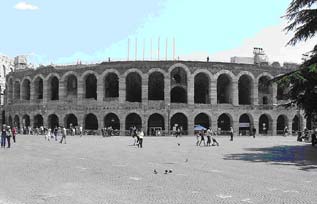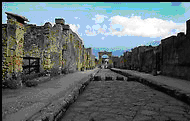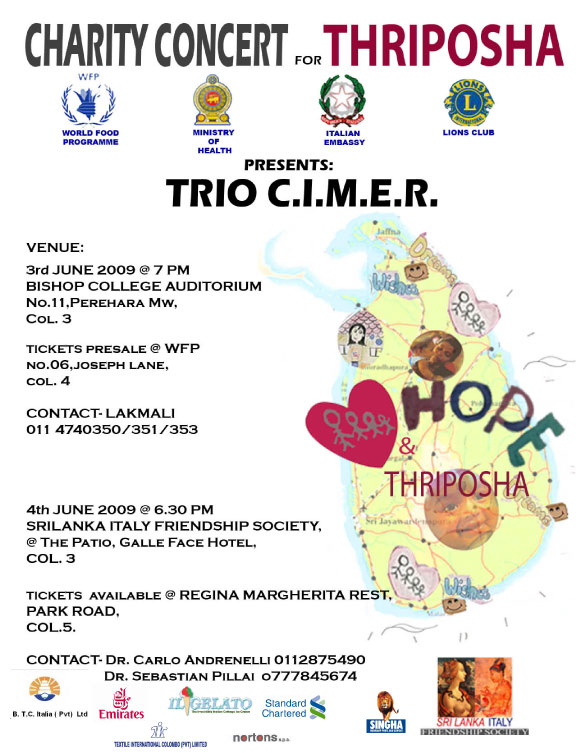 |
|
Ambassador of Italy in
Sri Lanka
His
Excellency
Pio Mariani |
After four years of my tenure of the Embassy of Italy in Colombo, and approaching for me the date to leave Sri Lanka, it is time to take stock of the bilateral relations between our two countries. I am happy to say that they have dramatically increased.
Trade has more then doubled, with the balance heavily in favour of Sri Lanka. In spite of the conflict, Italian investors have not turned away, but have kept their confidence in the long term possibilities of the Srilankan economy. During the past years, new investments have been made in the textile, tourist and confectionery sectors.
I believe that the defining occasion at the origin of the tremendous strengthening of the bilateral relations is to be identified in the widespread participation of Italy in the post tsunami reconstruction.
Almost 100 million euros of Italian public and private funds have been spent for the implementation of over 100 projects. The experience of common work thus acquired has brought together the peoples of our countries, fostering our mutual knowledge and understanding.
Another important element that has contributed to the strengthening of the bilateral relations is represented by the decision of the Italian Government to reiterate the yearly provision of a quota for working visa in favour of Srilankans, that, along the years, has increased from 1000 to 3500.
Visits at political level have intensified, thus creating the conditions for a closer and more structured and intensified dialogue on bilateral and international matters.
Certainly, instrumental for the further development of economic, political and cultural bilateral relations has been the commendable decision of Srilankan Airlines to re-establish a service of direct flights from Colombo to Rome, which was inaugurated by H.E. the President Mahinda Rajapakse himself, last November.
When I arrived, four years ago, the air was full of hopes and expectations, after the terrible natural disaster that struck Sri Lanka. It seemed that the common effort for reconstruction could have a positive impact in the attempt to find a pacific solution to the ethnic question.
Unfortunately, it was not to be. Now, that the LTTE deadly threat to peace and development in Sri Lanka has been eliminated, and that arms are finally silent, after almost thirty years, I think that the conditions are right for the resurgence of those hopes and expectations.
Sri Lanka is facing a new beginning. Italy hopes that, in the following months, the political forces and the various communities of Sri Lanka will approach the problems ahead with understanding, sensibility, magnanimity, fairness, generosity and restraint, in order to identify together a political solution conducive to forming a new Sri Lanka, in which each and everyone could feel a stakeholder with equal rights. Only a comprehensive and shared solution will bring Sri Lanka the peace and the prosperity she deserves, creating the conditions for the full exploitation of her tremendous potential.
Finally, let me take this opportunity to convey the most heartfelt thanks of the Italian President, H.E. Giorgio Napolitano, and of all the Italians for the expression of solidarity and sorrow received from many Srilankans, after the deadly earthquake that struck Italy, last April.
 |
|
Map of Italy |
|
Italy (long form) Italian Republic
Capital City Rome (pop. 5,208,000) (2006 est.)
Cities (largest by population) Milan, Naples, Rome, Palermo, Venice, Turin, Bologna
Currency Euro
Holiday (national) Republic Day, June 2
Independence Day March 17, 1861
Language Italian, others
Population 58,103,000 (2006 est.)
Religions Catholic
|
 Rome
Founded more than 2,700 years ago, Rome is the largest open-air museum in all of Europe and very photogenic. Major attractions include The Vatican, Trevi Fountain, Trastevere, the Spanish Steps, Coliseum, Pantheon, Piazza Navona, and the views from Gianicolo Hill. The "Eternal City" is romantic, fashionable and a favorite destination for visitors from around the world.
|

Venice
Located in northeastern Italy, Venice is widely considered Italy's (and the world's) most beautiful and romantic city. Literally standing in a lagoon just barely above the water line, it consists of 117 islands, and the city is connected by over 400 bridges that cross its 150 canals. It's small and compact, and the traffic-free streets (no vehicles allowed) along the winding canals are great for walking and sight-seeing. There are many magnificent churches and palaces, lively piazzas and interesting shops here. |
 The Arena of Verona, the world stage of opera
The Roman amphiteatre, the Arena of Verona is one of the greatest and most prestigious archeological monuments in Europe. Built in the first century A.C. during the last years of the emperor Augustus, its ellipsis is 138,77 m. long, from one end to the other.
From the very beginning of its existence, the Arena has been a powerful and suggestive place of entertainment: gladiatorial fights, jousts, tournaments and nightly games took place against a rich scenic background.
The first interventions to recover the Arena's function as a theatre began during the Renaissance.
Some opera performances were later mounted in the building during the 1850s, owing to its outstanding acoustics.
From the 18th century onwards, theatrical performances became a constant feature of the Arena. The solemn Congress of the European Nations, which took place in Verona in 1822, deserves a special mention: on that occasion, Rossini composed and directed in the Arena the cantata "La Santa Alleanza" (The Holy Alliance), for all European sovereigns.
The Arena of Verona has become famous for being the most important contemporary "archeological theatre". The good state of preservation of the monument is clearly due to the way the monument has always been used.
As it was in the past, the amphitheatre continues to be important place for culture, and a harmonious meeting point for society.
The Arena is in fact the location of one of the most famous Opera festivals in the world, attracting opera fans from all over the world.
The first performance of the Festival dates back to August 10th, 1913 when Aida by Giuseppe Verdi was performed. Nowadays, four productions are mounted each year between June and August.
The Opera Festival has had, some of the best artist in the world such as: Renata Tebaldi, Maria Callas, Mario del Monaco, Placido Domingo, Jos� Carreras, Luciano Pavarotti, Jean Vilar, Franco Zeffirelli, Tullio Serafin, Riccardo Muti, Daniel Oren.
The opera season of the Arena brings to Verona over half a million people every year, and over fifteen thousand specators flow into the amphitheatre every evening of the season: a cosmopolitan crowd, with people from both within and outside Europe.
|
 POMPEI, THE ROMAN CITY REDISCOVERED
Built by the Oscans, around the 9-8th century B.C. Pompeii soon made contact with the nearby Greek colonies, quickly absorbing their culture, way of life and religion.
When Rome began its gradual advance towards southern Italy and started to overcome the resistance of the Italic peoples, also Pompeii ended up under Roman dominion.
In 80 B.C. it became a Roman colony with the name of Colonia Cornelia Veneria Pompei. Pompeii's flourishing economy led to a decisive population increase, widespread affluence and the remarkable embellishment of the town. The middle-class derived great pleasure also from competing with the nobility in the construction of splendid villas.
However, the life and splendour of Pompeii was destined to come to an end.
It was indeed on the 24th August in the year 79 A.D. that a heavy shower of ash, lapilli and lava from the Vesuvius volcano began to rain down onto the city and onto nearby Herculaneum and Stabiae.
All was buried beneath a thick blanket of volcanic material to a depth of several metres. The inhabitants, who for the most part fled in the direction of the coast, were suffocated by the fumes of the gases, others met death in their own homes.
The city remained buried form many centuries and was rediscovered in the 16th century. Its excavation by archeologists began in 1748, and continued systematically through the nineteenth century up today, aimed at restoring and attributing the proper value to the ancient city and its exceptional archeological heritage.
Since then, its excavation has provided an extraordinarily detailed insight into the life of a city at the height of the Roman Empire. Today, it is both one of the most popular tourist attractions of Italy and a UNESCO World Heritage Site.
The excavated town offers a snapshot of Roman life in the 1st century, frozen at the moment it was buried on 24 August 79. The objects buried beneath Pompeii were remarkably well-preserved for almost two thousand years.
The lack of air and moisture allowed for the objects to remain underground with little to no deterioration, which meant that, once excavated, the site had a wealth of sources and evidence for analysis, giving remarkable detail into the lives of the Pompeiians in their everyday life.
Details abound concerning professions and categories, such as for the "laundry" workers (Fullones). Wine jars have been found bearing what is apparently the world's earliest known marketing pun, Vesuvinum (combining Vesuvius and the Latin for wine, vinum). Graffiti carved on the walls shows us real street Latin (Vulgar Latin, a different dialect from the literary or classical Latin).
Two-thirds of the city has been excavated, but the remnants of the city are subject to deterioration. A visit to Pompeii therefore represents a unique experience through which it is possible to come back to the life at the times of Roman Empire enjoying a unique scenario belonging to the past still perfectly preserved.
|

THE LEANING TOWER OF PISA
The Leaning Tower of Pisa or simply The Tower of Pisa is the freestanding bell tower, of the cathedral of the Italian city of Pisa. Situated behind the cathedral, it is the third oldest structure in Pisa's Cathedral Square together with the cathedral and the baptistry.
The Tower of Pisa was a work of art, performed in three stages over a period of about 177 years. Construction of the first floor of the white marble �campanile� began on 1173, The tower began to sink after construction progressed to the third floor in 1178.
This was due to a mere three-meter foundation, set in weak, unstable subsoil. Construction was subsequently halted for almost a century, because the Pisans were almost continually engaged in battles with other cities such as Genoa, Lucca and Florence.
It was built by Tommaso di Andrea Pisano, who succeeded in harmonizing the Gothic elements of the bell-chamber with the Romanesque style of the tower.
The height of the tower is 55.86 m (183.27 ft) from the ground on the lowest side and 56.70 m (186.02 ft) on the highest side. Its weight is estimated at 14,500 metric tons (16,000 short tons).
The tower has 296 or 294 steps. the tower was previously leaning at an angle of 5.5 degrees, but after the restoration works between 1990 and 2001 it was reduced an angle of 3.99 degrees. The top of the tower is 3.9 metres (12 ft 10 in) from where it would stand if the tower were perfectly vertical.
In 1987, the tower was declared as part of the Piazza dei Miracoli UNESCO World Heritage Site along with the neighbouring cathedral, baptistery and cemetery.
On January 7, 1990, after over two decades of work on the subject, the tower was closed to the public, the bells were removed to relieve some weight and cables were clinched around the third level and anchored several hundred meters away.
After a decade of corrective reconstruction and stabilization efforts, the tower was reopened to the public on December 15, 2001, and has been declared stable for at least another 300 years.
In May 2008, after the removal of another 70 metric tons (77 short tons) of earth, engineers announced that the Tower had been stabilized and that it had stopped moving for the first time in its history.
(Sources: Italian Embassy in Sri Lanka / Internet)
|
 |
|